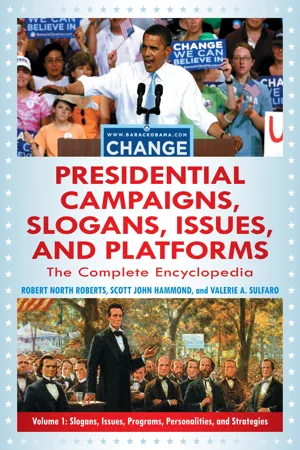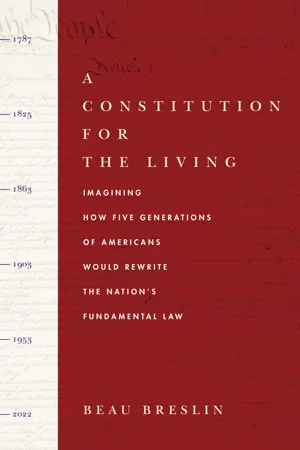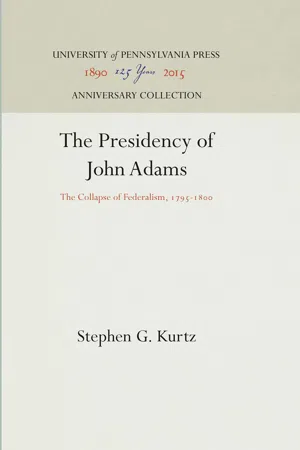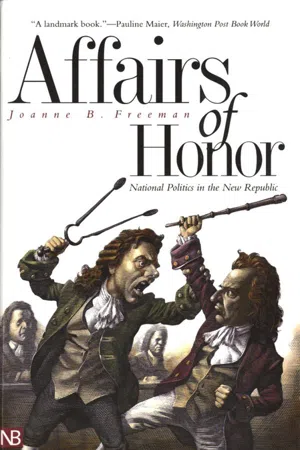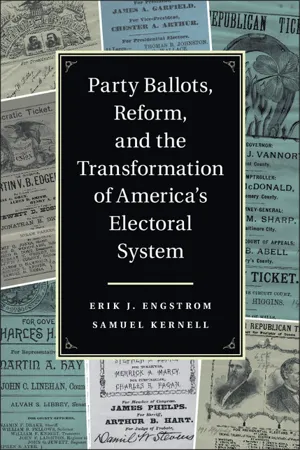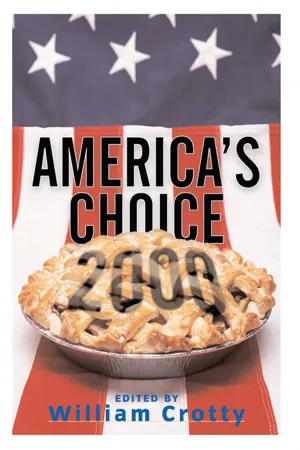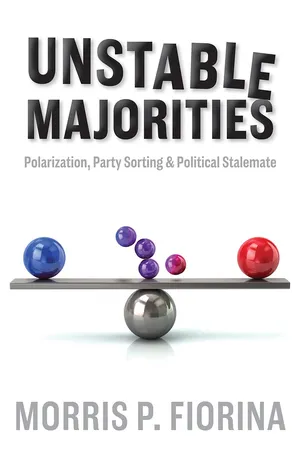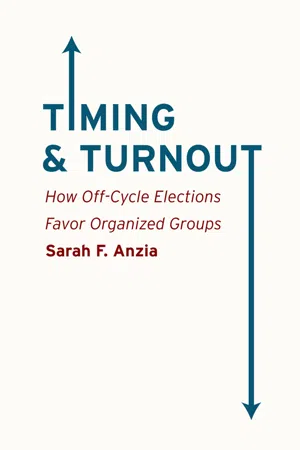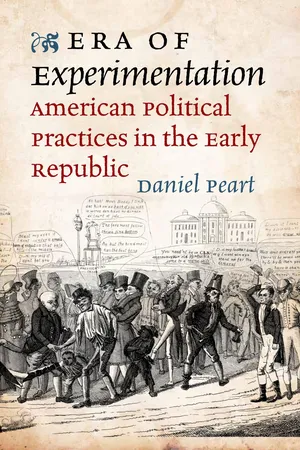History
1824 Presidential Election
The Presidential Election of 1824 was a significant event in American history marked by a contentious and controversial outcome. It was the first election in which the popular vote did not directly determine the winner, leading to a "corrupt bargain" between John Quincy Adams and Henry Clay. This election ultimately contributed to the formation of the Democratic Party and the beginning of the modern two-party system in the United States.
Written by Perlego with AI-assistance
Related key terms
1 of 5
10 Key excerpts on "1824 Presidential Election"
- eBook - ePub
Presidential Campaigns, Slogans, Issues, and Platforms
The Complete Encyclopedia [3 volumes]
- Robert North Roberts, Scott John Hammond, Valerie A. Sulfaro(Authors)
- 2012(Publication Date)
- Greenwood(Publisher)
Given the storm and stress of the campaign, the actual election was anticlimactic. Jackson won impressively in the popular vote: between 642,000 and 647,000 (around 55%–56%) going for Jackson, with somewhere between 500,000 and 508,000 (43%–44%) votes for the incumbent president. Jackson’s margin of victory among the popular vote would stand as the highest in the nineteenth century. Reflecting the popular will, the Electoral College this time gave Jackson a decisive majority: 178 electoral votes to 83 (or 68% for Jackson to 32% for Adams). President Adams held all six New England states as anticipated and also won in New Jersey, Delaware, and Maryland, the Maryland vote being nearly split—6–5 in favor of Adams. Even though Adams lost in New York, he managed to pluck 16 of the Empire State’s 36 electoral votes, Jackson still winning a majority of 20. There was nothing left to question this time around; Andrew Jackson was decisively the president-elect. Three candidates received votes for vice president: the incumbent Calhoun, easily winning reelection with 171 votes and following the example of New York’s George Clinton by becoming, along with Clinton, historically one of two vice presidents to serve two different presidents (Clinton having served under both Jefferson and Madison). Adams’s Secretary of the Treasury, Richard Rush of Pennsylvania, received 83 vice presidential votes for the National Republicans, and William Smith of South Carolina won seven votes from the Georgian delegation as a protest against Calhoun’s mistreatment of native son William Crawford when the two men worked together in the Monroe administration. It would not be the first time that Calhoun was the object of personal retribution.The election of 1828 is often regarded by historians, political scientists, and students of electoral politics as the watershed event in the democratizing of presidential selection. To an extent this is accurate, as the election was characterized by what was at the time unprecedented citizen participation. But it is also misleading to an extent, as presidential elections had been gradually and noticeably moving in this direction for two decades. Whether or not historians can arrive at a clear enough understanding of this era to satisfy all the angles, the election of Andrew Jackson to the presidency definitely pointed the country toward the formal institutionalization of the modern two-party system and helped to establish the shape of things to come. Furthermore, Jackson’s triumphs in 1828 and later in 1832 assembled and solidified a varied coalition within the Democratic Party that included the allegiance of aristocratic southern planters (and thus slave owners), western entrepreneurs, small farmers in the West as well as in the North, and diverse immigrants residing in larger numbers within the more heavily populated cities, particularly in the North. In a word, Jackson’s ascent relied upon the first of many “coalitions” that would help to define the Democratic Party throughout much of its history. For these and other reasons, President Jackson would greatly contribute to the formation of the American political system that we know today. Indeed, the fact that these events opened what is now universally called “the Age of Jackson” speaks volumes with regard to his pivotal role in American history. And indeed, in many ways it was indeed Jackson’s age, but it is only fair to remark that former president John Quincy Adams was not nearly finished with public life. President Adams may have left the executive branch under unfavorable conditions, but he would soon eagerly return to the public arena, serving with distinction in the House of Representatives, wherein he his colleagues assigned him the nickname “Old Man Eloquent” due largely to his speeches condemning slavery, and thereby earning a name as one of the preeminent American statesmen in any era. And President Jackson’s legend survived the mudslinging barrage of 1828 and continued to loom larger than life through the duration of his presidency and beyond. - eBook - ePub
A Constitution for the Living
Imagining How Five Generations of Americans Would Rewrite the Nation's Fundamental Law
- Beau Breslin(Author)
- 2021(Publication Date)
- Stanford University Press(Publisher)
Paul Nagel writes of the debated issues of the time, “men still recalled the Missouri struggles, the abortive Vesey rebellion, the tariff and internal improvement tensions, as well as other public issues which had helped delineate regional interests.” 2 These were big issues—important issues!—and ones that dominated the headlines. It was against this backdrop that Webster contemplated his role not only in selecting the President but also in advancing the fundamental interests of the young, and somewhat fragile, United States. * * * The 1824 Presidential Election and the 1825 contingent election occurred at a crucial political moment. What troubled Webster shortly after the contingent election was a deeply philosophical problem. The New Englander brooded over the role of the individual citizen in the election of the U.S. President and in American politics more generally. “The America of 1824 was recognizably a republic, in the sense that ultimate sovereignty lay with the people, but much less a democracy, in which the people engage directly in the political process.” 3 But now, the political landscape was shifting from one dominated by republican ideals to one far more democratic. The Twelfth Amendment hadn’t slowed that shift, and Daniel Webster worried that nothing in the 1787 Constitution would prevent the inevitable. As Webster and everyone else in politics knew, political parties in America no longer existed as they once did. James Monroe’s sweeping victory in the 1820 presidential election had proved the Federalist Party a relic of the past and the Jeffersonian party the unchallenged victor. 4 The Federalist Party to which Webster had dedicated his political career lay in ruins, absorbed in pieces by coalitions that sought to challenge the only national political party left: the Democratic-Republicans. The election of 1824 was the first time, in fact, that not a single candidate had run on a Federalist ticket. All the candidates ran as Democratic-Republicans - eBook - PDF
The Presidency of John Adams
The Collapse of Federalism, 1795-18
- Stephen G. Kurtz(Author)
- 2017(Publication Date)
4 The Candidates of 1796 HAVING SETTLED THE GREAT FOREIGN POLICY ISSUE OF WASH-ington's second administration, the politicians turned with what must have been a sense of profound relief to the more familiar arguments and devices of electioneering. T h e third presidential contest in the history of the United States, while it was fought out by party organizations that had arisen in response to the administration program, was nevertheless de-cided by what were primarily local or regional issues. T h e President would be chosen only indirectly by the people, and whether Federalists or Republicans would prove vic-torious in state contests for the electoral college often rested on nothing more than the popularity of local politicians. Regional loyalties were stronger than devotion to the new Federal compact, the sense of nationality was yet unde-veloped, and the isolation of most communities such that mo-mentous national issues roused far less interest than the sea-board and urban newspapers of the time imply. Perhaps the most important single factor in the contest (if newspaper sources may be trusted at all) was the personal popularity of the candidates for high office. T h e election of 1796 was vigorously contested, because for the first time opponents of the administration saw a chance to win. Washington was expected to retire from public life, and as the new year opened one of the men most vitally concerned with that eventuality was already contemplating its consequences. 78 The Candidates of ¡796 79 In perfect secrecy between you and me, wrote John Adams to his wife, I must tell you that I now believe the President will retire. The consequence to me is very serious, and I am not able, as yet, to see what my duty will demand of me. Adams concluded that he could only wait, watching the events of the next few moments with close scrutiny, in the hope that Providence would show the way. - eBook - PDF
Affairs of Honor
National Politics in the New Republic
- Joanne B. Freeman(Author)
- 2008(Publication Date)
- Yale University Press(Publisher)
Each election reshaped the political landscape, revealing a new cast of characters fighting under each ban-ner. The brief hiatus of partisan strife during the first few months after Adams’s election was the product of just such a political reshuffling. Uncertain of new political alliances and enmities, curious to see how the presidential election of 1800 227 Jefferson, Adams, and their political friends would align themselves, the political community waited and watched; even radical Republican newspaper editor Benjamin Franklin Bache declared an official cease-fire in his Philadelphia Aurora . 48 As bodies of principles, Republicanism and Federalism held rea-sonably constant, but individual commitments remained unreliable and unpredictable. Elections forced politicians to declare their loyal-ties; in a murky world of shifting alliances and undeclared intentions, they were bursts of light that revealed in a flash the lay of the political landscape. 49 In 1800, national politicians revisited this disturbingly un-predictable landscape, determined to prevent a recurrence of the prob-lems of four years past. Looking back at the election of 1800 in his later years, Burr would regret that he had not heeded more closely the lessons of 1796. The Election of 1800 For Burr the election of 1796 had been a painful experience—so humil-iating, in fact, that he excluded it from his memoirs. Encouraged by his Virginia friends only to be betrayed at the height of the contest, Burr remembered this emotional lesson when Republicans invited him to run for vice president again in 1800. When John Nicholson asked him whether he cared to run, the normally self-possessed Burr “ap-peared agitated[,] declared he would have nothing to do with the busi-ness[,] that the Southern States had not treated him well on a similar occasion before, that he thought their promise could not be relied on.” He repeated his sentiments to John Taylor of Caroline in a more char-acteristically sardonic strain. - Erik J. Engstrom, Samuel Kernell(Authors)
- 2014(Publication Date)
- Cambridge University Press(Publisher)
2 The Puzzle of Responsive Elections The presidential election of 1880 is most often remembered for its violent aftermath. The assassination of President James Garfield, just six months into his administration, by a jilted job seeker, casts a long historical shadow over the election. But what many political scientists will find more intriguing about 1880 is the election itself. It featured one of the highest voter turnouts – 80 percent of eligible voters – and narrowest presidential vote margins in American history. The 8 million presidential votes broke in favor of Garfield by just more than 2,000, yet they were distributed efficiently, allowing him to eke out a narrow Electoral College majority and keep the White House under Republican control. But perhaps the election’s most remarkable feature is the breadth of the Republican victory in Congress and across the nation. Republicans retook control of the House of Representatives for the first time since 1872. Whether Republicans would wrest control of the Senate from Democrats would not be officially decided until the state legislatures convened the following January. Yet Republicans had ample cause for optimism. Of the twenty-seven non-Southern state legislatures elected that year, Republicans won a majority in both legislative chambers in twenty states and split control in two others. Among these wins were bicameral majorities in six legislatures served by lame-duck Democratic senators. Early the following year the final wave of the Republican victory lapped into Washington with the election of the narrowest possible Senate majority – that is, requiring the Republican vice president’s tie-breaking vote. Considering the Framers had carefully designed the upper chamber to withstand “impetuous” swings of public sentiment by staggering terms and setting up indirect elections, these results are all the more striking. And yet we can see in Table 2.1 that this outcome was unexceptional for the era.- eBook - ePub
America's Choice 2000
Entering A New Millenium
- William Crotty(Author)
- 2018(Publication Date)
- Routledge(Publisher)
Eight The Election in Perspective: Two Nations, Four PartiesJohn Kenneth WhiteTHE 2OOO PRESIDENTIAL ELECTION WILL BE FOREVER REMEM -bered not for what the candidates said or did during the campaign, but for how it ended. Not since the disputed Hayes-Tilden contest of 1876 has there been so much drama, confusion, and excitement. The trouble began on election night, when the broadcast network projections gave the state of Florida to AI Gore, then to George W. Bush, then to nobody. It only got worse when the same networks called the presidency for Bush only to take back their declaration a few hours later. And it ended when, for the first time in history, the Supreme Court of the United States determined the winner. But that body's certification of George W. Bush as the nation's 43rd President was not a triumph for our democracy or its institutions; rather, it happened only because Al Gore and the Democrats reluctantly surrendered.When it comes to selecting a president, Americans want the process to be both fair, yet provide for majority rule; deliberative as well as quick; representative, but with some having a greater voice than others. Viewed from this perspective, the 2000 election failed on all counts. Many did not see the electoral count as fair; rather, the candidate who won the popular vote did not become president. It was neither deliberative, as the courts rushed to beat the clock set by the Congress and the Florida legislature. Nor was it quick, as the turmoil dragged on for five weeks after the balloting. Finally, the five members of the Supreme Court that foreclosed all recounts were not the "greater voices" either the voters or the framers had in mind. AI Gore, correctly, did not hail George W. Bush on his election, rather he congratulated Bush "on becoming the 43rd president of the United States."1 There is a difference. Because Bush was confirmed by the Supreme Court, his becoming president is likely to be an even more daunting task than it was for Gerald R. Ford, the first man to serve who had neither stood for the presidency nor the vice presidency. Ford's ascension came as a result of a decision by elected officials to remove the corrupt Richard M. Nixon from office—a process that most Americans accepted as legitimate. Bush, on the other hand, enters the White House thanks to the unelected members of the Supreme Court. The result is a serious erosion of public trust. A disturbing 48 percent say their confidence in the election system has been seriously shaken, and an even more alarming 37 percent claim that Bush is not a legitimate president.2 - eBook - ePub
Unstable Majorities
Polarization, Party Sorting, and Political Stalemate
- Morris P. Fiorina(Author)
- 2017(Publication Date)
- Hoover Institution Press(Publisher)
CHAPTER 10 The 2016 Presidential Election—An Abundance of ControversiesEven by the colorful standards of presidential primaries, the 2016 election cycle has been filled with jaw-dropping, head-scratching moments .—Eric BradnerWhile the world celebrates and commiserates a Donald Trump presidency, one thing is clear: this will go down as the most acrimonious presidential campaign of all .—Rachel ReveszControversial presidential elections are nothing new in American electoral history, 2016 being the latest, but certainly not the first. Despite much apocalyptic commentary, however, the implications of the 2016 election seem less dire than those of some elections held in earlier eras. The four-candidate 1860 election started the country on the path to civil war and the disputed election of 1876 threatened to reignite that conflict. In more recent times, the strong showing of a racist third party in 1968 coupled with political assassinations and civil disorders on a scale not seen since the labor violence of the early twentieth century led some contemporary observers to believe that the country was “coming apart.”1 The 2000 Florida electoral vote contest raged for more than two months, threatening a constitutional crisis and deeply dividing partisan activists on both sides. Still, even allowing for the fact that secession and revolution are not seriously on the table, for the sheer number and breadth of the controversies that accompanied it, the 2016 election does seem out of the ordinary.Parties have nominated flawed candidates before—Republican Barry Goldwater in 1964 and Democrat George McGovern in 1972, for example—but at least since the advent of scientific survey research, no major party has nominated a candidate so wanting in the eyes of the electorate, let alone both doing so simultaneously. Charges of ethnocentrism and racism are as American as apple pie, but in their prevalence and virulence in 2016 (with misogyny added to the toxic mix) they were reminiscent of 1928, if not the late nineteenth century.2 “Biased media” is a complaint common to all elections, but the retreat from objectivity by the mainstream media in 2016 struck many observers as a significant break with modern journalistic practices.3 The increasingly visible role of social media like Twitter threatened to further diminish the importance of the legacy media. Swing voters, largely missing in action in recent elections, suddenly reappeared in 2016.4 Possible foreign intervention in the election was a new development (at least insofar as the United States was the intervenee rather than the intervener), as was FBI involvement (but possibly only because earlier instances did not become public). Meanwhile journalists scrambled to read up on “populism,” which had not played such a significant role in American elections since the 1960s. “Class,” long ago displaced by discussions of race, ethnicity, gender, and sexual orientation in college course syllabi, enjoyed an academic as well as political revival (so did “authoritarianism,” another oldie but goodie).5 - eBook - ePub
A Short History of Presidential Election Crises
(And How to Prevent the Next One)
- Alan Hirsch(Author)
- 2020(Publication Date)
- City Lights Publishers(Publisher)
11 Meanwhile, the war hero Jackson enjoyed the greatest popularity with ordinary Americans, and benefited from the kind of grass-roots campaign that was at the time uncommon in America.In the latter part of the twentieth century, there would be much reference to the “endless campaign” or “perpetual campaign” for president. As it happens, the phenomenon of the next presidential election starting virtually as soon as the previous one concludes goes way back. In January 1822, with Monroe’s second term less than a year old, the political writer Hezekiah Niles lamented the excessive time spent by politicians and others “in electioneering for the next President of the United States.”12 A few months later, another journalist noted that the “electioneering begins to wax hot.”13The election of 1824 was, in a sense, the first modern presidential election, replete with campaign biographies, straw polls, and other campaign accoutrements that would eventually become commonplace. Many state legislatures held conventions that drafted resolutions endorsing a candidate. On February 14, 1824, the U.S. Congress held its quadrennial “caucus” to anoint its own candidate. This had become the traditional means for Republicans to select their nominee, but in 1824 the caucus came under heavy criticism for bypassing the people at large. As a result, all but Crawford’s supporters (and even some of them) boycotted the caucus. Crawford received sixty-two of the sixty-six votes cast, but this Valentine’s Day massacre may actually have harmed his candidacy, since Crawford was tarred as the beneficiary of an elitist cabal. A Jackson supporter from Pennsylvania expressed a widespread sentiment when he attacked the caucus as a game played by “the friends of a single individual, held in utter disregard or defiance of the known wishes of the Democratic Party in Congress and throughout the Union.”14 - eBook - ePub
Timing and Turnout
How Off-Cycle Elections Favor Organized Groups
- Sarah F. Anzia(Author)
- 2013(Publication Date)
- University of Chicago Press(Publisher)
CHAPTER THREE Partisan Power Play Election Timing Politics in the Nineteenth CenturyThe United States was not born with its current electoral calendar. In the early years of the republic, there was tremendous variation in when states held their general elections for governors, state legislatures, and members of the US House of Representatives. Even presidential elections were held on different days in different states. To know what cities and towns did prior to the 1830s, one would have to consult individual city and state records, but it is generally believed they held elections on days other than state and national elections because their voting requirements were different.1Over the course of the nineteenth and early twentieth centuries, however, the American electoral calendar evolved. Fairly early in the nineteenth century, the day of presidential elections was made uniform across states. One by one, between the 1840s and the early twentieth century, most state elections were shifted to November so that they coincided with what became the national Election Day. Far less is known about how the timing of local elections has changed over the years, but somehow, political decisions have resulted in a dizzying array of election dates for counties, cities, towns, school districts, and special districts in which off-cycle scheduling remains the norm.This chapter begins to investigate why elections in the United States are held when they are. Why are some elections—such as congressional elections, most state elections, and some local elections—conducted according to the same schedule as US presidential elections, whereas other elections are held separately from national and most state races? What explains the variation in election timing across governments and within governments over time? These are important questions to answer, for three reasons.The first has to do with methodological challenges to testing the theory presented in the last chapter. Because it is highly unlikely that any governmental official would be willing to randomly assign governments on-cycle and off-cycle election schedules, empirical tests of the effects of election timing have to rely on observational data. And since the variation in election timing we observe in the world is almost certainly nonrandom, one has to know something about the process that generated that variation in order to design an empirical analysis that estimates causal relationships. By examining the history of election scheduling and learning about the politics of election timing choice, it becomes possible to conduct a more careful and informed analysis of election timing’s effects. - eBook - ePub
Era of Experimentation
American Political Practices in the Early Republic
- Daniel Peart(Author)
- 2014(Publication Date)
- University of Virginia Press(Publisher)
4
“YOU MUST ORGANIZEAGAINST ORGANIZATION”
The Presidential Election of 1824
Written during the canvass by John C. Calhoun, himself a candidate for the White House, the following appraisal of the presidential election of 1824 presents a stark contrast to the standard celebratory narrative, which paints political parties as agents of democracy:It cannot be doubted that a party has grown up in our country, who aspire to the government of the Union, not th[r]ough the confidence and attachment of the people, but by a dextrous use of what is called party machinery. The great object of the party has been to enlist in its cause political leaders, who were supposed to possess a control over the machinery and in this it has succeed[ed] to a great extent. They are now struggling to give to this machinery the highest possible force.1In the eyes of most modern scholars, the emergence of mass parties signaled the dawning of the Age of the Common Man. To Calhoun, however, the rise of party portended something else entirely: government of the politicians, by the politicians, for the politicians.The object of Calhoun’s ire was William H. Crawford. Crawford and those that backed his bid for the presidency sought to make the campaign a referendum on the proper role of party in a republican polity. In their hands, they contended, party would be an organ of good government, facilitating the rule of the majority and restraining the improper ambition of individuals. But this vision did not go unchallenged. Crawford’s rivals united to condemn his version of party as a tool for self-serving politicians, while defending their own right to organize in opposition. In this chapter, then, as in chapter 1 , we see that neither partisanship nor antipartisanship is as monolithic as they sometimes appear.The 1824 election also provides a lesson in the motives of these early party builders. Scholars have suggested that parties were created to serve three main functions: to engage and mobilize a mass electorate; to translate popular preferences into legislative outcomes; and to regulate access to public office.2 In chapter 2 the opponents of slavery demonstrated that nonpartisan organizations were capable of performing the first of these functions, and in chapter 3
Index pages curate the most relevant extracts from our library of academic textbooks. They’ve been created using an in-house natural language model (NLM), each adding context and meaning to key research topics.
